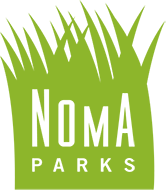
NoMa Neighborhood
NoMa Now
Since the NoMa-Gallaudet U Metro station opened in 2004 (initially named New York Ave-Florida Ave-Gallaudet U), NoMa has become the fastest-growing neighborhood in Washington, D.C. As of the end of 2018, NoMa has more than 13.2 million square feet of office space and 4,800+ new apartments. More than 54,000 people work in NoMa each day, and more than 44,000 people live in the greater NoMa neighborhood.
If the current pace of development continues, NoMa will be completely built out by 2024. At that time, it will likely include more than 8,000 residential units, roughly 22 million square feet of office space, a number of significant retail/mixed-use projects, and several hotels. For more information about the NoMa neighborhood, please visit the NoMa BID website.
Notwithstanding this truly remarkable wave of development and revitalization, one critical element was overlooked when the District planned the redevelopment of the area: PARKS.

NoMa History
On the NoMa BID’s website you can read the whole story, but here’s the condensed version:
Originally inhabited by Piscataway Indians, the area now known as NoMa began to develop in 1792, when Florida Avenue (then known as Boundary Street) was established as the rural boundary of Washington, D.C. By the mid-1800s, NoMa was primarily farmland settled by working-class Irish. The immigrant residents named the area “Swampoodle” for the swampy land and puddles created from overflows of the Tiber Creek, a now-buried waterway that runs roughly along North Capitol Street. Swampoodle was largely characterized by brick rowhomes similar to those seen in historic residential areas of Washington, D.C.
In 1856, President Abraham Lincoln established Gallaudet University to the northeast of Swampoodle, at the intersection of Florida Avenue NE and 6th Street NE. In 1860, the Government Publishing Office was established by an Act of Congress at the corner of North Capitol Street and H Street NW, and the following year, President Lincoln appointed the first Printer of the United States.
With the building of Union Station in the first decade of the 20th century, over 100 homes were condemned to make way for track and terminal construction, displacing and physically dividing Swampoodle residents. Once this rail hub was established, the area north of the station and west of the tracks became heavily industrial, with warehouses and coal yards.

In 1941, Uline Arena, later known as the Washington Coliseum, opened its doors as an ice hockey and basketball arena and, in 1964, famously hosted the first Beatles concert in North America. Uline Arena is also remarkable because it was the District’s first integrated large venue in an otherwise segregated Washington, D.C.
As rail transportation declined, the area experienced disinvestment and deterioration. The NoMa area, blocks from the U.S. Capitol and with excellent transit assets, consisted mostly of vacant lots.
Throughout the 1980s and 1990s, commercial development began in the blocks directly adjacent to Union Station. Toward the end of the 1990s, incorporated as part of a broad initiative for the Economic Resurgence of a struggling Washington, D.C., focus turned to the great location and transportation assets of the NoMa area. That plan renamed the area “NoMa” for “North of Massachusetts Avenue” and introduced, as Action 29, the notion of the public-private partnership for development of a new Metro station between Union Station and Rhode Island Avenue. The development of that station — WMATA’s first infill station — was NoMa’s first successful public-private partnership, and its impact on the neighborhood has been nothing short of profound. The public-private partnership committed to NoMa Parks is the second time that NoMa stakeholders have come together to demonstrate that remarkable things can be achieved through public and private sector collaboration.
NoMa Parks Foundation © 2024


